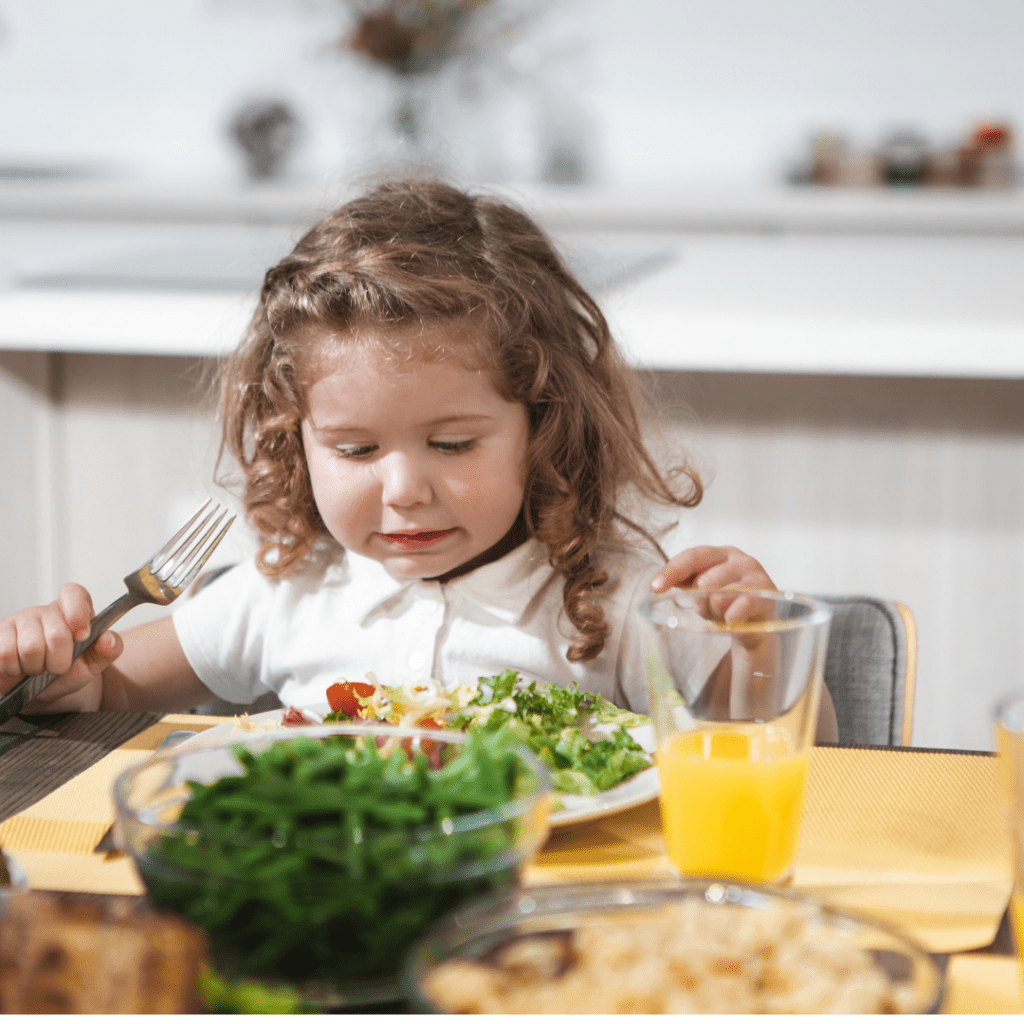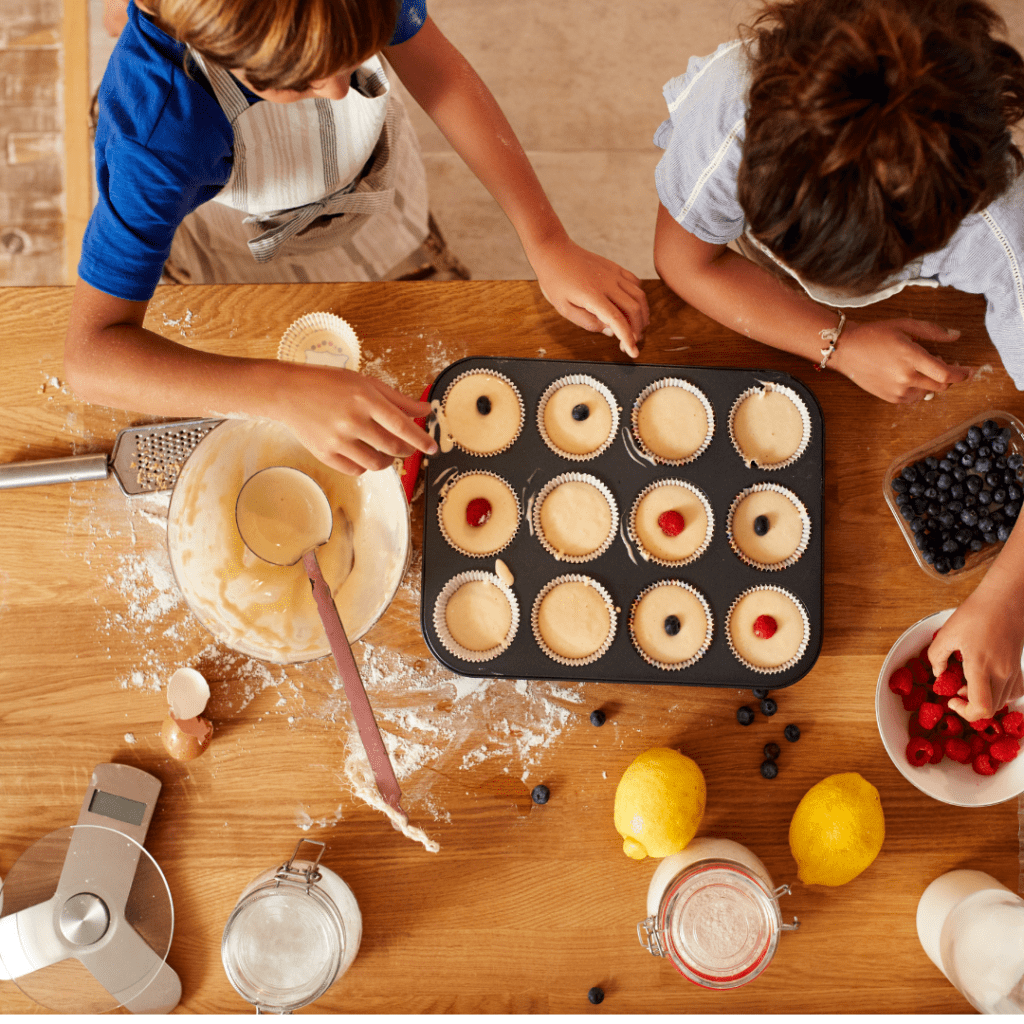Food for Thought: Setting Up the How to Eat before the What to Eat.
The first part of our 3-Part Raising Healthy Eaters Series was all about establishing the Basic Three Pillars for Building a Balanced Plate for our children’s growth & development. Meeting your kids where they are at with the foods that they feel safest with (the known foods) within the 3 Key Pillars to raising Healthy Eaters (COMPLEX CARBOHYDRATES, HEALTHY FAT, & PROTEINS) is the foundational first step.
Now in part two, we are going to talk about some tips in HOW you can set the stage at home to introduce the IDEA of adding in new nutrient-dense whole foods into your child’s meals in a way that does not cause a food strike in the home and helps lay the groundwork for healthy relationships with food in the future.
“But Joanna, what if your kids only want mac’n’cheese every day and nothing else?!?” Our kids can dig their heels in pretty good on refusing to eat their food, especially if there is an “unknown” aka new food on the plate we are trying to introduce. “It looks weird,” “smells funny”, or “tastes gross!”, are some of the classic responses we can get as parents when we are trying to encourage our kids to expand their palate and eat a variety of foods.

When they refuse to eat new foods, it pulls on many of our heart strings and the “well, I don’t want them to go hungry….” So, we go and make the mac’n’cheese so they eat something. Then… we end up becoming the short order cook making multiple meals, we can get trapped in that cycle where our child is not eating an array of nutrients, they need for their development, we cave and give them what they want, and then we feel stuck in knowing how to break this pattern?
I can tell you I have been there as a mom and I have sat with many mamas on the phone listening to them cry in total frustration at not knowing how to stop that cycle once it starts. The younger you can break it the better, if we cater and cave every time by the time, they are 10- or 12-years old is can be a hard habit to break, and we don’t want to feel like a kitchen slave to the picky eaters and having to make multiple meals.

First, it’s important to know you are not alone if you are going through this stage with your child.
Second, having awareness that as a parent the food industry is 100% marketing to our kids through recognizable cartoon characters on the box, to high concentrated levels sugars, oils, and “natural flavourings” that makes popular kids packaged snack food both highly desirable and addictive. This is why of course they want the Bear Paws Cookies over a celery and hummus… what food is more fun and stimulates our child’s brain chemicals wanting more? The packaged foods over the whole foods often win in our child’s eye’s making it a bit harder on us parents.
Thirdly, understanding that it’s a process. It is never about perfection but progression in your child’s ability to try new foods and enjoy more whole foods that come from the dirt and less foods that come from a package or box. This will take time but as a parent we need to help establish a palate for whole foods early on, use small swaps, and encourage variety in our weekly menu at home.
I always get asked by parents “what do I feed my kid?” but I like to start with How we eat and How we set the stage to help even the most picky eater have a greater chance of success in becoming a more flexible eater:
Establish an Eating Routine:
When meals and snack times are consistent during the day this supports the child feeling like they have control in their days. Autonomy is important as children discover who they are and what control they have in their life. If they can walk into the kitchen and ask for a snack any time of the day, it can feel a bit more chaotic for them, and then they want to exert more control over what they eat. Where if you typically offer a snack at a similar time each day (10 am-11 am, 2 pm-3 pm) then there is more safety in that predictability during their day and they cognitively are more open to take more risks and explore new foods when the routine is consistent.

Respect the Natural Hunger Cues
Now this might sound like this is in opposition to the establishing routines recommendation above, but it is complimentary when done together. We want our children to learn to listen to when their body is truly hunger vs. eating out of boredom, for emotional reasons or because its “dinner time”. This supports your child having a trusting relationship with their bodies hunger signals and intuitive eating rhythms at a young age that will serve them in their adult years. So, continue to offer food during the eating routine times but if they are not hunger don’t push too hard, we want to respect our child appetite (or lack thereof), we want to teach them to recognize when they are really hungry (which can help with emotional eating issues later). So, if your child is not hungry don’t force the meal.

Try not to use food to bribe or reward a child’s behavior.
I am sure many people can relate to hearing “if you clean your plate, you can have dessert”, or “if you clean your room, you can have ice cream”, if you get an A on that test, we can order pizza”. This can be a slippery slope and can set our kids up to look for emotional comfort, love, appreciation, reassurance or even acceptance with food. This might not only ignite but also reinforce a power struggle with you over food now and with themselves later in life. In addition, your child might associate mealtimes with feeling of frustration, anxiety and/or become less sensitive to their own hunger cues. Withholding dessert can also give the message that dessert is the “best food”, and your child has to suffer through the not so yummy dinner food for the good stuff which can send the wrong message and drive up the desire for more sweets. It is best to keep rewards and food not in the same category.

Patience is Your Greatest Tool
Kids can say “no” to a new food based on its appearance or they do the tiny bird size bite and put it down and say, “I don’t like it”. Be patient with introducing a new food and never right off a food after only ONE try. Your child will need repeated exposure with one food. Introduce one new food at a time and offer it with a food that you know is one of their favourites so it’s a new food versus a whole new meal experience. Bring the one food item back in with a few different cooking techniques. Think of cauliflower, we can boil it, roast it, grill it, have it as rice, puree it into a white pasta sauce or add it into a pasta casserole. You can try and try again with that one food item a few deferent ways before you say it’s a no food. Often, we see a child say a hard no to the boiled cauliflower but then is asking for seconds when it’s unknowingly mashed into potatoes! Get creative, hard fun, and come at it a few different angles before you throw in the towel.

Practice setting up a supportive environment and a healthy relationship with food and their body with these tips, continue to add in one new food at a time in a fun and creative ways onto the 3-pillar plate we created in part one of this Raising Healthy Eaters Series. We will take the next step in Series 3; practice these tips this month and I will see you back next month for part three.
In great health,
Jo
PS: Check out my Raising Healthy Eater Ebook! over 168-pages of top tips and tasty recipes!



